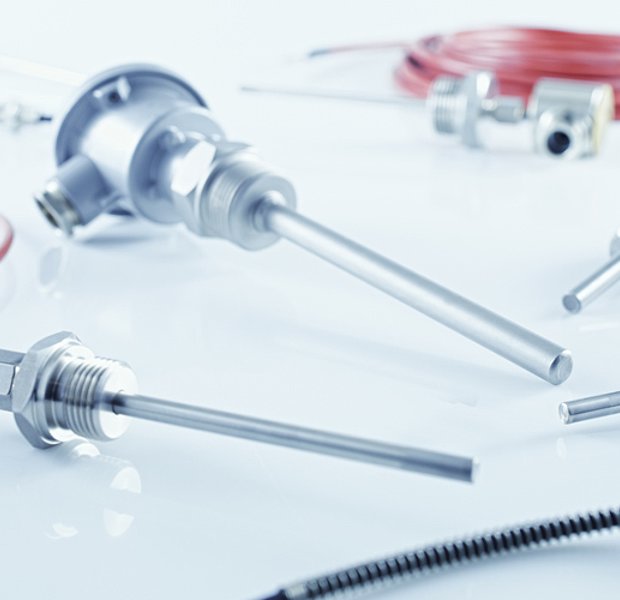
Screw-in thermometer
The spectrum of screw-in resistance thermometers covers a large number of versions of thermometers in a huge range of different housings. For each thread, the sensors can be screwed directly into a threaded hole with screw-in housing, clamp screw connections or protective fitting and installed safely at the measuring point.
Technical information on screw-in thermometers
General
The group of screw-in resistance thermometers covers a large number of versions of thermometers in a huge range of different housings. The spectrum ranges from simple screw-in housing with a connected feed to rigid screw connections or mobile clamp screw connections, to a wide range of connection heads with protective valve and different process connections. Thanks to rigid or mobile fittings, the resistance thermometers can be adjusted individually to each installation situation and are quick and easy to install.
Use
Fields of use include bearing temperature monitoring in drive machinery and temperature measurement in vessels and piping, especially in plant engineering, laboratory applications and the chemical industry. Many versions are certified as per IECEx and ATEX for use in explosive areas.
Sensors with screw-in housing are often used in positions with limited space, such as on the front face of machine housing or to monitor surface temperatures. In drive technology in particular, the temperature is a key indicator of the machine’s condition. A rise in temperature usually indicates a deviation of the permissible operating parameters. Thermometers with smaller heads of construction EM 24 and EM 38 are the ideal choice here. They are used whenever the space available for the connection heads is also very limited, for example on bearing shells of engine or generator shafts. In preventative maintenance, monitoring with bearing thermometers not only increases the machine’s life expectancy but also prevents unnecessary shutdowns and failures. Special implementations with a measuring range up to +400°C are also possible for raised temperature requirements.
Screw-in resistance thermometers with DIN connection heads are mainly used in larger machines, piping systems and boilers.
Operating principle
Simple screw-in thermometers consist of a measuring resistor with a supply line (measuring insert) and screw-in housing made from brass, aluminium or stainless steel. The measuring resistor and part of the supply line is sealed in small screw-in housing or connected rigidly to the housing with a press squeeze.
More complex screw-in thermometers consist of a measuring insert, the housing or a valve with process connection and an optional connection head. Head measuring transmitters can also be integrated into the connection head as an option. The dimensions, design and material of the valve need to be tailored to the features of the installation location.
Despite the wide range of different uses, some standard dimensions have become established on the market. There are four different shapes. Protection pipes with a consistent 6 mm for use in smaller apparatus and piping. Protection pipes with a consistent 9 mm, the most commonly used construction, and sensors with a protection pipe diameter of 11 mm that are designed for greater mechanical loads. In chemical industrial applications, the most common form is the NAMUR form, in which the protection pipe diameter tapers from 9 mm to 6 mm at the measuring tip.
INFORMATION: NAMUR is an abbreviation of “Normenausschuss für Mess- und Regeltechnik in der chemischen Industrie” [standards committee for measuring and control technology in the chemicals industry].
In screw-in thermometers with connection heads, one or two Pt100 resistance sensors are installed in a stainless steel protective valve and given an optional supply line. The measuring resistor is electrically insulated from the protection pipe and embedded in heat-conducting paste for better thermal coupling. The protection pipe is filled with ceramic filler to increase its shock resistance. The temperature is measured in an almost isolated position at the front of the protection pipe. The cable transition from the sensor to the feed, or the compensation line in thermocouples, is inside the sensor head. The feed is conducted away axially from the fitting insert of the sensor head. Rigid or mobile fittings are available as accessories.